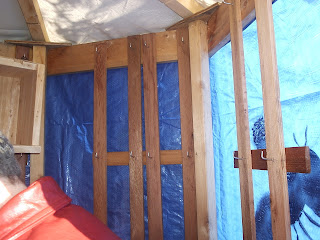Charley, an old friend of mine started with mason bees a few years back. He loves the challenge of wood and design. We often talked about the yurt. At one point he asked me "What do you need, how long and high must this be..?". He said "Ï'll have a go". Some time later he came back with his yurt in the back of his red pickup truck. He said, "I do wood work, but I don't know anything about sewing".
The structure was complete, but it needed a tarp. So, I bought some tarp material and set to work. Draping the tarp around the uprights was easy. A few staples held it in place. It took me a bit more work to do the roof.design. The tricky part with the roof is that you cannot have any folds, because the bees might get caught in amongst the material. I ended up stapling the material to the roof after sewing the pieces together.
Charley's yurt design. We painted a black bee design on it - just for the fun of it.
 Inside of Charley's designed yurt. A piece of plywood over the uprights held the base of the roof pieces. The upper parts of the roof pieces were attached to the roof hexagon.
Inside of Charley's designed yurt. A piece of plywood over the uprights held the base of the roof pieces. The upper parts of the roof pieces were attached to the roof hexagon.
 |
| The corner uprights were made from 1.5 x 1.5 inches. Two pieces of thin lath was used to hold one Highrise with nesting trays. Each Highrise was hung onto the lath with two hooks. |
 |
| Tim standing next to Charley's finished yurt. |
 |
| Three rows of Highrises fit into this size yurt. Each Highrise is filled with our Quicklock Eco-Corn trays |
 |
| Soil is added to the extra length of tarp to prevent wind from going underneath the tarp. |
This yurt worked great: Mason bees did not get caught in any part of the structure, during the day the temperature was always warmer inside ( but never over 30 Celsius). It is definitely sturdy. I did try it out in Cawston BC, and I was told that it may get very windy on some days. To make sure the yurt did not topple , I tied 3 guy ropes to eye hooks and to a fence. More recently I have simplified this by setting the yurt adjacent to a sturdy post and tying a rope around the yurt and fastening the rope to the post. This works well.
However, this design is a little complex- we are mainly speaking about the complexity of the roof design. Also, not everyone has a welder so that pieces of re bar can be fastened to each of the six 'feet' of the yurt.
We need a design that is simple to assemble and set out in a garden.
Over the next week or I want to tell you about our other yurts, their advantages and disadvantages. I want to show you our yurts made of re-bar and made of irrigation pipe.
I also have a collection of photos of what people have found in their mason bee nests. Fascinating!...More next time.



No comments:
Post a Comment